#AI race
Explore tagged Tumblr posts
Text
#Tags:AI and Automation#AI Ethics#AI Governance#AI Leadership#AI Race#Artificial Intelligence#Centralized Power#Elon Musk#Ethical AI Development#facts#Geopolitical Risks#Global Inequality#Innovation and Society#Job Displacement#life#OpenAI#Podcast#Privacy Concerns#Sam Altman#serious#SoftBank#Stargate Cluster#straight forward#Surveillance Technology#Technological Monopolies#truth#upfront#website
1 note
·
View note
Text
Technological Competition: The New Cold War in AI Development
Introduction: The Global AI Race
Artificial Intelligence (AI) is not just a technological advancement—it is a tool for geopolitical dominance. The race to lead in AI development has quickly become the new "Cold War" for technological superiority, with countries vying for global influence through innovation. India and China, two rising powers in the global AI race, are engaged in this competition, not just for technological advancement, but for broader geopolitical positioning. The winner of this race will hold significant leverage in global markets, cybersecurity, and military might, reshaping the international order.
India and China’s AI Race: Strategic Motivations and Differing Paths
China’s approach to AI development is aggressive and expansive, driven by its ambition to become the global leader in AI by 2030, as outlined in its "New Generation Artificial Intelligence Development Plan" (2017). China sees AI as a key to enhancing its global competitiveness, strengthening its military, and asserting its dominance in sectors like manufacturing, healthcare, and national security. Its significant investments in AI infrastructure, research, and development underscore its commitment to becoming an AI superpower.
India, on the other hand, has taken a more measured approach, focusing on AI for social inclusion, economic growth, and democratic governance. India's AI strategy, outlined by NITI Aayog in 2018, emphasizes "AI for All," aiming to harness AI's potential to address societal challenges in sectors like agriculture, healthcare, and education. While India’s strategy focuses on leveraging AI for inclusive growth, its efforts to scale AI innovations to compete globally are still in their nascent stages.
The contrasting motivations behind India and China’s AI policies—China’s for global dominance and India’s for societal benefit—reflect their broader geopolitical aspirations. However, the divergence in their AI strategies also highlights the technological gap between the two nations, which has significant implications for global power dynamics.
AI and Economic Competitiveness
AI is poised to reshape the global economy by enhancing productivity, automating processes, and fostering innovation. China’s early adoption and massive investments have given it a significant edge in AI-driven economic competitiveness. Chinese companies like Alibaba, Tencent, and Baidu have integrated AI into various industries, creating a robust AI ecosystem that fuels their global expansion. China’s AI investments in manufacturing, logistics, and healthcare have not only boosted its domestic economy but also positioned it as a critical player in global supply chains.
India, while progressing in AI research and development, faces challenges in scaling AI applications across industries. Although India has a growing start-up ecosystem and a strong IT sector, it lacks the infrastructural investments and comprehensive AI strategies seen in China. Nevertheless, India's potential to become an AI hub for the developing world cannot be overlooked. The Indian government’s focus on creating AI solutions for its vast and diverse population provides a unique model of AI deployment, one that prioritizes inclusivity and social welfare over sheer economic dominance.
Global Influence and Geopolitical Consequences
The AI race between India and China extends beyond economic competition; it is also about gaining geopolitical influence. China's AI strategy is intrinsically linked to its geopolitical ambitions. Through initiatives like the Belt and Road Initiative (BRI) and its growing investments in AI research, China is exporting its AI technologies to developing countries, influencing the global AI standards and creating dependencies on Chinese technology. This raises concerns about digital sovereignty and the spread of authoritarian AI governance models, particularly in surveillance and data control, which China uses to maintain its own domestic security.
India, on the other hand, is positioning itself as a counterbalance to China’s growing influence. By advocating for responsible AI development, India promotes a more ethical and democratic approach to AI governance. India’s participation in international forums, such as the Global Partnership on Artificial Intelligence (GPAI), signals its intent to influence global AI standards while safeguarding democratic values.
However, to truly challenge China’s dominance, India must increase its investment in AI infrastructure, foster international collaborations, and scale up its AI research efforts. The challenge for India is to compete with China while adhering to its principles of transparency, data privacy, and ethical AI development.
The New Cold War: AI and Future Power Dynamics
As AI becomes the backbone of economic and military power, the competition between India and China will shape the future balance of power in Asia and beyond. China’s rapid progress in autonomous systems, AI-driven cybersecurity, and military applications presents a formidable challenge to India’s national security and sovereignty. India’s response must involve not only bolstering its AI capabilities but also forming strategic alliances with like-minded countries to resist China’s growing influence in AI governance and technology standards.
Conclusion
The AI race between India and China is more than just a competition for technological superiority—it is a battle for global influence and economic power. China’s aggressive push for AI dominance threatens to reshape the global order, while India’s democratic and inclusive AI model offers an alternative path. However, the technological gap between the two nations poses a significant challenge for India. As the new Cold War of AI intensifies, India must accelerate its AI investments and forge international collaborations to protect its interests and promote a more responsible and ethical AI-driven future.
#AI competition#New Cold War#AI race#India China rivalry#Global AI dominance#AI and geopolitics#Technological competition#AI for global power#China AI strategy#India AI strategy#AI in economics#AI and national security#Belt and Road Initiative#Responsible AI#AI for social good#Geopolitical influence#AI infrastructure#AI standards#Digital sovereignty#AI and global governance
0 notes
Text
I heard some interesting takes on the e/acc twitter spaces last night that not asking for subsidies to win “AI Race” against China, the accelerationists were positioning themselves to be in an adverserial relationship with regulators in Washington and Para Governmental Orgs.
AI is a hot topic and the organizers back east have to do something. If they aren’t marshaling resources to boost local efforts against China, then they are going to regulate the operations at home, and mediate arguments between them and decels.
1 note
·
View note
Text
Little detail I loved in Dune Part Two was Irulan recoding her notes on a futuristic phonograph cylinder because the AIs fucked things up so badly the entire human race is now fanatically opposed to anything as advanced as a calculator.
#dune#dune part two#frank herbert#princess irulan#irulan corrino#dune spoilers#they hated ai so much they made the entire human race dependant on space coke just to function
3K notes
·
View notes
Text
Google is falling behind in AI arms race, senior engineer warns
A senior software engineer at Google wrote a critique asserting that the internet search leader is losing its edge in artificial intelligence to the open-source community, where many independent researchers use AI technology to make rapid and unexpected advances. The engineer, Luke Sernau, published the document on an internal system at Google in early April. Over the past few weeks, the document…

View On WordPress
#AI#ai companies#AI race#ai tools#Alphabet#artificial intelligence#ChatGPT#Google#Google AI#meta#OpenAI#OpenAI ChatGPT#Sundar Pichai
0 notes
Note
hey! i’m an artist and i was wondering what about the httyd crossover art made it obviously AI. i’m trying to get better at recognizing AI versus real art and i totally would have just not clocked that.
Hey! This is TOTALLY okay to not have recognized it, because I DIDN'T AT FIRST, EITHER. Unfortunately there’s no real foolproof way to distinguish real art from the fake stuff. However I have noticed a general rule of thumb while browsing these last few months.
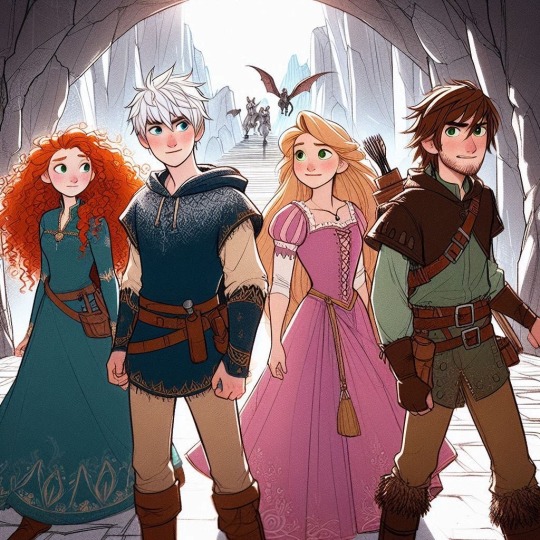
So this is the AI generated image I used as inspiration. I will not be tagging the account that posted it because I do not condone bullying of any type, but it’s important to mention that this was part of a set of images:
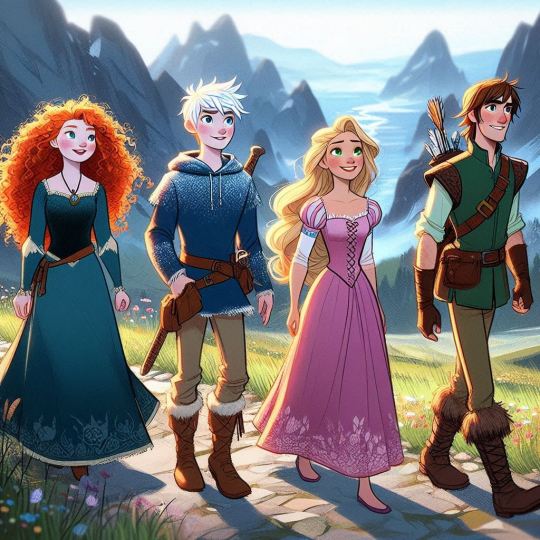
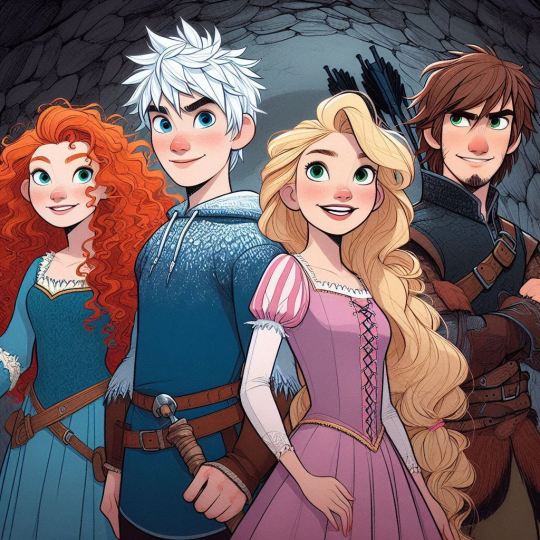
This is important because one of the BIGGEST things you can use to your advantage is context clues. This is the thing that clued me in: right off the bat we can see that there is NO consistency between these three images. The art style and outfits change with every generated image. They're vaguely related (I.E. characters that resemble the Big Four are on some sort of adventure?) and that's about it. Going to the account in question proved that all they posted were AI generated images. All of which have many red flags, but for clarity's sake we'll stick with the one that I used.

The first thing that caught my eye was this???? Amorphous Blob in the background. Which is obviously supposed to be knights or a dragon or something.
Again, context clues come into play here. Artists will draw everything With A Purpose. And if what they're drawing is fanart, you are going to recognize most of what you see in the image. Even if there are mistakes.
In the context of this image, it looks like the Four are supposed to be running from these people. The thing that drew my attention to it was the fact that I Didn't Recognize The Villains, and this is because there is nothing to recognize. These shapes aren't Drago, or Grimmel, or Pitch, or any other villain we usually associate with ROTBTD. They're just Amorphous Blobs that are vaguely villain shaped.
Which brings me to my second point:

Do you see the way they're standing? There is no purpose to this. It throws the entire image off. Your eye is drawn to the Amorphous Villain Blobs in the background, and these characters are not reacting to them one bit.
Now I'm not saying that all images have to have a story behind them, but if this were created by a person, it clearly would have had one. Our group here is not telling a story, they are posing.
This is because the AI does not see the image as a whole, but as two separate components: the setting, and the description of the characters that the prompter dictates. I.E. "Merida from Brave, Jack Frost from ROTG, Rapunzel from Tangled, and Hiccup from HTTYD standing next to each other"
Now obviously the most pressing part of this prompt are the characters themselves. So the AI prioritizes that and tries to spit out something that WE recognize as "Merida from Brave, Jack Frost from ROTG, Rapunzel from Tangled, and Hiccup from HTTYD standing next to each other".
This, more times than not, is going to end up with this stagnant posing. Because AI cannot create, it can only emulate. And even then, it still can't do it right. Case in point:



This is not Hiccup. The AI totally thinks this is Eugene Fitzherbert. Look at the pose. The facial structure. The goatee. The smirk. The outfits. He's always next to Raps. Why does he have a quiver? Where's Toothless? His braids? His scar??

HE HAS BOTH OF HIS LEGS.
The AI. Cannot even get the most important part of it's prompt correct.
And that's just the beginning. Here:

More amorphous shapes.
So these are obviously supposed to be utility belts, but I mean. Look at them. The perspective is all off. There are useless straps. I don't even know what that cluster behind Jack's left arm is supposed to be.
This is a prime example of AI emulating without understanding structure.


You can see this particularly in Jack, between his hands, the "tassels" of his tunic, and the odd wrinkles of his boots. There's just not any structure here whatsoever.
Lastly, AI CANNOT CREATE PATTERNS.
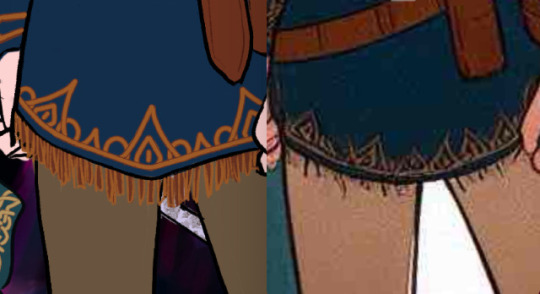
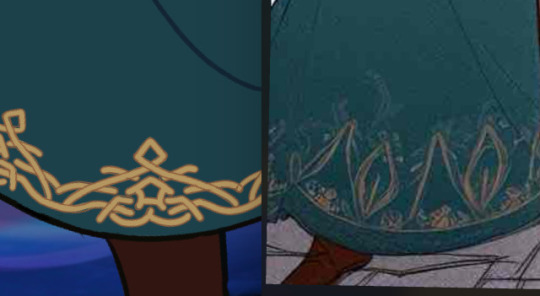
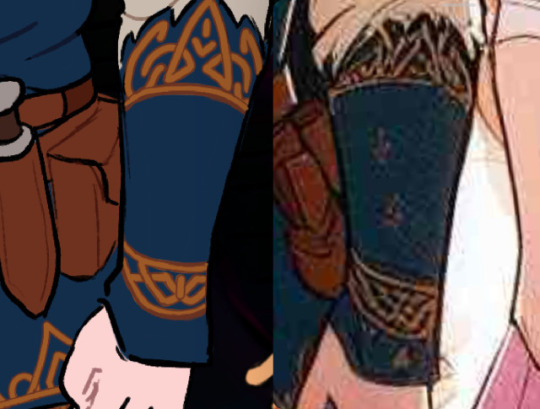
Here are the side-by-sides of the shit I had to deal with when redesigning their outfits. Please someone acknowledge this. This killed me inside. THIS is most recognizable to me, and usually what I look for first if I'm wary about an art piece. These clusterfuck bunches of color. I hate them. I hate them so. much.
Anyways here's some other miscellaneous things I've noticed:

Danny Phantom Eyes

???? Thumb? (and random sword sheath)

Collarbone Necklace (corset from hell)

No Staff :( No Bow :(

What is that.
So yeah. Truly the best thing to do is to just. study it. A lot of times you aren't gonna notice anything just looking at the big picture, you need to zoom in and focus on the little details. Obviously I'm not like an expert in AI or anything, but I do have a degree in animation practices and I'm. You know. A human being. So.
In conclusion:

(Y'all should totally reblog my redesign of this btw)
#rotbtd#the big four#anti ai#ai discourse#fanart#ask#inbox#rise of the brave tangled dragons#httyd#how to train your dragon#hiccup horrendous haddock iii#brave#tangled#rapunzel#merida#jack frost#rotg#rise of the guardians#dreamworks#disney#hijack#frostcup#jackunzel#jarida#mericcup#hicunzel#crossover#hicless#rtte#race to the edge
1K notes
·
View notes
Text
The Pride Pin
"Have you got a little rainbow flag? Or maybe a rainbow handkerchief?" Edward asked the man behind the counter. He was on his way to a gay wedding and had seen a large pride flag in the window of this store which had given him an idea. "Basically something that I could put into my breast pocket for a wedding i'm going to." Before quickly adding: "To show my support to the grooms that is."
"Ah, how nice, although I'm afraid I only have large flags at the moment, but I do have a few pins left over from Pride, would one of those work for you?" replied the shopkeeper as he pointed to a box a little further down the counter.
"Looks perfect" Edward said as he picked up one of the pins.
"Just to check - you did say you wanted it to show you're an ally of the gay community didn't you? It's just that some of the items in this store can be a little, well, unpredictable, so just wanted to be clear about things before you try it on."
"Of course" Edward lied.
In truth Edward hadn't wanted to go to this wedding at all. He worked with one of the guys getting married, John. They had joined a law firm at the same time so had met during their induction and had been good friends for a while - at least until John had come out as gay and started dating guys. Edward was glad that John was happy, but had since mostly avoided hanging out together unless it was a work event. He had gone to one dinner soon after John's engagement to his boyfriend, Miguel, but had spent the whole meal feeling embarrassed. Everyone else at the table had been so obviously gay and they had made no attempt to talk quietly, so he was sure all the surrounding tables had been judging him all evening.
When Edward had received the invite to the wedding he had initially planned to decline it. What had changed his mind was the fact that a lot of John's straight female friends were going to be there, and with most of the other guys at the wedding being gay, it was almost guaranteed that he would hook up with one of the girls. He hoped that the pride pin was going to be the 'icing on the cake' with regards to getting attention from the girls. How could they turn down a guy who was so supportive of his friend? With any luck he would be back at home with a lady before the happy couple had even cut the cake.
"Here, let me put it on for you" the shopkeeper offered.
Edward had intended on keeping the pin out of sight until he had entered the wedding, but he didn't want to offend the shopkeeper so let him reach over and place the pin on his lapel - he'd just take if off as soon as he left the store.

Edward looked at the mirror behind the counter and his first thought was to worry that the pin might make the girls at the wedding think he was gay too. He started to wonder if it was a bad idea, and as if to confirm that he felt the pin prick his chest. Soon after he felt another prick and he wondered if the shopkeeper had failed to cover the back of the pin properly. When he started to feel more and more pricks on his chest, and not just where the pin was, he began to worry that something was wrong.
Edward felt like he was being stabbed with needles all across his chest and he felt like he had no choice but to pull his jacket off. He didn't know what was going on, but he needed to stop whatever was causing the pain.
Edward was confused. He had taken off his jacket and the pricking sensations had stopped, but when he looked down at his chest he didn't understand what he was looking at as it. What he first saw on his chest was a mix of colors that hadn't previously been there. It was as though someone had covered his chest in paint.
"¿Cómo?" Edward said aloud whilst continuing to stare at his chest. He had never had a tattoo so didn't understand what he was looking at. As he reached up to rub off whatever was on his chest it quickly dawned on him that the colors were not going to come off easily.
"What is this? Is this a tattoo? How do I get this off?" Edward asked in increasingly frantic tones, all with a slight Spanish accent. He had been so fixed on the new tattoos that he hadn't noticed that the rest of his body had taken on a subtle tan.
The shopkeeper didn't reply, he knew that if an item from his shop was not used as intended it could cause a little confusion for the customer, so he just waited to see what would happen.
"What is going on? And what's wrong with my voice?" Edward asked as he started to get angry. "I'm a dancer at Infernos nightclub and if you want to see me shake my ass... wait... no I meant to say i'm a dancer, no a dancer..." Edward had wanted to tell the shopkeeper that he was a lawyer at a powerful law firm and would kick his ass if he didn't fix what was going on but he didn't seem able to get the right words out.
Whilst Edward's mind tried to deal with what was going on, he started to wonder what sort of options he had to get rid of the tattoo, or what he could do just to cover it up. It was then that he looked back at the mirror and realised how much else had changed across his body. His heart sank as he knew there was no way he could cover everything up.
Edward sighed as he thought again about what to do with the tattoos, but was then confused. Why was he thinking of covering them up? He loved showing them off. He had spent so much of his life hiding who he was, but now there was no one who was going to stop him from being his true self. He was Eduardo - a proud Latino twink.
Eduardo felt the jacket he was holding and then remembered that he had come in to buy a new shirt. "Hey, do you have any dress shirts?" he smiled as he asked the storekeeper. "My best friend is marrying some fancy lawyer today and I want to look good for the occasion!"

#ai image#gay#gay male#male tf#male transformation#reality change#transformation#race change#straight to gay#twink tf
375 notes
·
View notes
Text
AI Data Centers: Addressing Growing Power Demands
New Post has been published on https://thedigitalinsider.com/ai-data-centers-addressing-growing-power-demands/
AI Data Centers: Addressing Growing Power Demands


The AI revolution is in full swing, and that means a lot more data centers; industry experts predict a 33% increase in the number of data centers through the end of the decade. And with that increase will come an increase in electricity usage. Some states could see data centers account for as much as 36% of their total electricity consumption within the coming decade, according to EPRI’s recent load-growth scenarios. This AI-driven power demand will add to the substantial pressure on electricity grids already at risk of being overtaxed. According to many experts, in fact, AI could be responsible for a coming energy crisis.
However, that crisis can be averted with the adoption of on-site thermal energy storage systems, which allow for more flexible usage of energy without operational sacrifices to the always-on data center. Thermal energy systems can immediately reduce data centers’ strain on the grid, thus lowering the occurrence of brownout or blackouts, along with the need for additional utility-level infrastructure–a cost that would inevitably be passed onto consumers in their power bills. Ultimately, such storage systems could pave the way for more data centers coming online faster to meet growing demand for AI without making a significant impact on community energy infrastructure.
Thermal energy systems relieve pressure on the grid mainly because they allow for load-shifting, or the adjustment of the hours during which the data centers use the most electricity from the grid. Data centers can charge these storage systems with grid power during the hours when grid demand is lower, then release it to power operations during the hours when utilities are more strained by overall higher demand from consumers. Data centers’ using such systems to store energy for and power AC systems alone can make a big difference because cooling systems must run 24/7 to keep critical equipment from overheating, and often make up some 40% of a center’s power usage.
The Global AI Race Is Set to Require Large Amounts of Energy
The recently announced $500 billion Stargate Project, led by a group of major tech companies, is going to need dozens of gigawatts of electricity. As Chinese startup DeepSeek AI recently showed, AI may indeed become more efficient regarding cost and energy, but many experts expect AI to remain a significant source of high power demand.
In fact, even before these AI announcements, data centers were on track to increasingly challenge US energy supply. According to the U.S. Energy Information Administration, power consumption is set to rise to record highs in 2025, with data center power needs an important factor.
According to experts, over the next decade data center power demands will put more than half of North America at risk of experiencing power reductions and even blackouts. Even where there is enough power, data centers are set to have a financial impact on everyone; studies show that data center demand and the subsequent squeeze on resources could drive electricity prices up by as much as 70%. A Bain & Company brief highlights how surging data center demand could threaten to overtake utility supply growth and require trillions of dollars in new energy investments globally. According to Bain, “Speed to market is vital for data center providers,” but local communities and regulators worry about grid reliability and environmental impacts.
Thermal Energy Storage Is an Immediate Solution That Benefits All Stakeholders
This is where thermal energy storage—a technology available now—can help. Designed for use with regular utility-provided electricity, energy is stored in water or ice, and released when needed to power the data centers’ cooling systems – usually during periods when demand – and also pricing – is high. This solution doesn’t require making a major infrastructure change; it can be retrofitted to existing buildings. Since it’s a behind-the-meter solution, data centers can install them independent of utilities – meaning that it is a quick and efficient way to relieve the grid.
If used widely, such systems can lower the likelihood of brownouts or blackouts during times of overall high demand. This load shifting will be especially important in states where power demand will be especially high for data centers. Solutions like thermal energy storage that help flatten the net grid impact provide utilities with more breathing room to integrate new resources, including solar and wind power, and expand transmission in an orderly fashion. Such solutions also reduce or at least slow down the need for utilities to expand infrastructure—potenitally reducing costs that would eventually be passed onto consumers via their power bills.
With a proven solution to reduce strain on the grid, new data centers will likely be able to gain necessary government approvals and operating permits faster, with less opposition or worry about staining local power sources, allowing this sector to grow faster and keep up with the increasing demand brought by AI.
Why Data Centers Should Act Now
There is also a financial benefit for data centers that incorporate thermal energy storage systems: With more utilities using differential pricing or time-of-use tariffs, based on demand or source of that energy, behind-the-meter storage can take advantage of these gaps in pricing, which are set to increase even more in the future, especially in states like California and others that are more reliant on solar energy during the day. Data centers can save money by charging the thermal system during the hours when power when it’s less expensive, and releasing it during peak hours – enabling them to reduce reliance on grid power at its more costly hours.
Thermal energy storage is also a safer option for data centers than lithium-ion battery-based storage. While small Li-On batters are common among residential consumers, large buildings like data centers would require large batteries, which present significant safety issues. The batteries often cannot hold a charge for more than 12 hours. They also degrade with time and require significant natural resources, including minerals, which are in short supply and sourced overseas. Many batteries are also made overseas, including in China, while thermal energy systems are primarily U.S.-made.
AI will bring many benefits – as well as challenges. The energy required to run a large data center consuming 100 MW of power, studies show, could supply some 80,000 homes with electricity. Multiply that by the many new data centers coming online and the impact is significant – one that could push prices up for everyone, as well as lead to energy shortages, brownouts, and even blackouts. AI is set to bring trillions in added value to the economy – but power issues could hurt that expected productivity. It doesn’t have to be that way; by adopting thermal energy solutions, the data center industry can lower its expenses and reduce the chance of blackouts.
#000#2025#ADD#Administration#adoption#ai#AI data centers#AI Race#America#amp#Announcements#batteries#battery#billion#brownout#buildings#california#challenge#change#China#Community#Companies#consumers#cooling#data#Data Center#Data Centers#deepseek#DeepSeek AI#economy
0 notes
Text

#sonic racing crossworlds#dr eggman#eggman#sage the ai#sage robotnik#sonic frontiers#sonic#giganto#my art
323 notes
·
View notes
Text
A change on the job site.
202 notes
·
View notes
Text
Mirror Muscle-this scene of an older man transforming into a young Latino stud originated with @max-the-many. He has some great captions and images so go check him out.
#ai generated#ai digital art#ai hunks#ai muscle#ai hunk#bodybuilder#clothed bodybuilder#bodybuilders#bodybuilding#ai video#race change#race tf#age regression
264 notes
·
View notes
Text
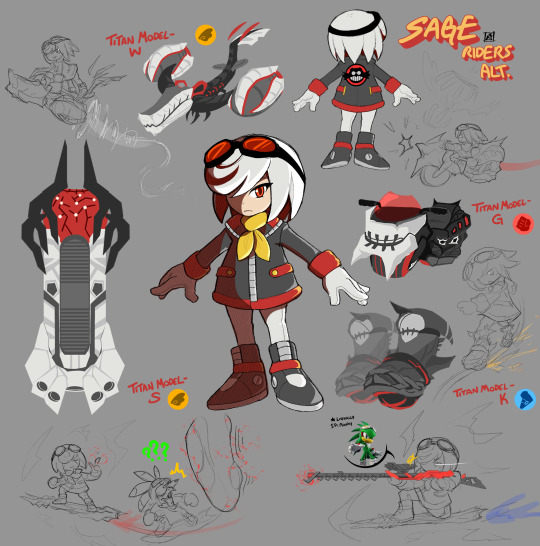
A small itty bitty little thing, Sage in Sonic Riders would go crazy haha PLEASE SEGA Bonus: She comes in Blue :)
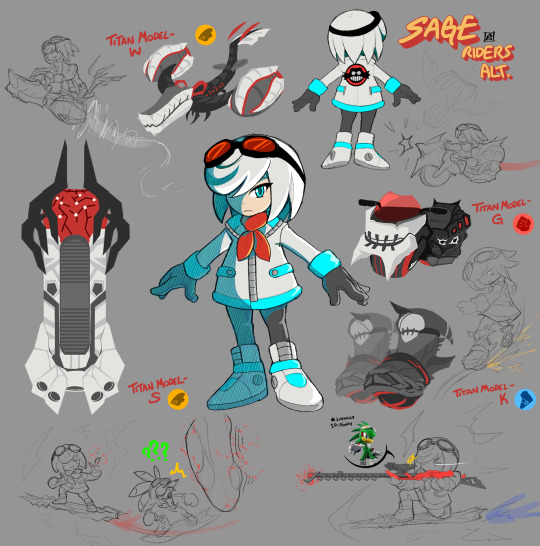
#digital art#art#sketch#artists on tumblr#sonic the hedgehog#sonic fanart#sage#sage robotnik#sage the ai#giganto#wyvern#supreme#knight#jet the hawk#sonic riders#sonic riders zero gravity#sonic racing crossworlds#extreme gear#sonic frontiers
199 notes
·
View notes
Text
Sage after barely being born for 1 game only to be in a death match of karts the next:

#StH#Sonic the Hedgehog#Sage Robotnik#it is p funny lol#esp since this is her first playable appearance#unless Im missing something but Im p sure Im not#she was only a cameo in tmosth after all#idk. its just funny that an already well received character has barely appeared even in the comics#only to be put in the mario kart spinoff the next real game shes in lol#sage the ai#sonic racing crossworlds
219 notes
·
View notes
Text

By Great Art Studio , I love this picture 😊
#art#art work#artworks#art works#cars#automobiles#vintage cars#automobile art#car art#art with cars#automotive#automotive art#paintings#illustrations#ai#ai image#digital art#creative art#fun art#historical art#racing#driving#old school cars#vintage car art#classic car art#automobile#great images#amazing images#great pictures
156 notes
·
View notes
Text
Going Down
When Jonathan wished he was younger, more agile, stronger and healthier, he had no idea what that would mean. Jonathan visited one of his construction projects. The conversion of an office complex into a luxury residential complex. And then came the first ZZZZING!

John was a real estate agent and was instrumental in selling the apartments. He couldn't afford the penthouses himself. Not yet. But at least he had secured one of the corner apartments on the fifth floor - not necessarily the best location in the building. But at least he had afforded himself such a prestigious address. And one day he would move into the 45th floor. He was sure of it. ZZZZING!
Jonny was more of a man for the rough stuff. He assisted the estate agent with letting properties. And if necessary, he also personally made sure that tenants left. If necessary, Jonny also collected rents. Or used more or less gentle pressure on tradesmen to ensure that they worked more carefully and stayed on schedule. And in the biggest emergency… ZZZZING!

Juan was a good craftsman. On building sites like this one, he was just a subcontractor. He didn't like doing that. But the economic situation was difficult. And the main thing was that he and his employees had work. And money. He wouldn't be able to afford an apartment in this building in his lifetime. But he worked hard and was diligent, he would eventually… ZZZZING!

Juancho had been lucky. It wasn't every day he got a job. But today he was able to show what he was made of. And maybe… You never know, maybe he would get a permanent job with Juan one day. Or even be able to actively support Jonny with his “tasks”.
Morphs by @ki-kink
173 notes
·
View notes
Text

Check out my AI Gurl Jen M at Pinterest.
She's HOT! 🏳️⚧️🏳️🌈
#ai model#transgender#trans community#transgirl#drag queens#drag queen#drag#drag king#drag performer#drag race#rupaul#queer#transfem#trans#pinterest#lgbtqia#crossdress#cross dressing#sissy crossdresser#sexy crossdressers#crossdressgirls#crossdresserlife#cute crossdreser#homosexual#gay fashion#homosexuality#lgbt#gay#homoerotism#homoerotic
262 notes
·
View notes